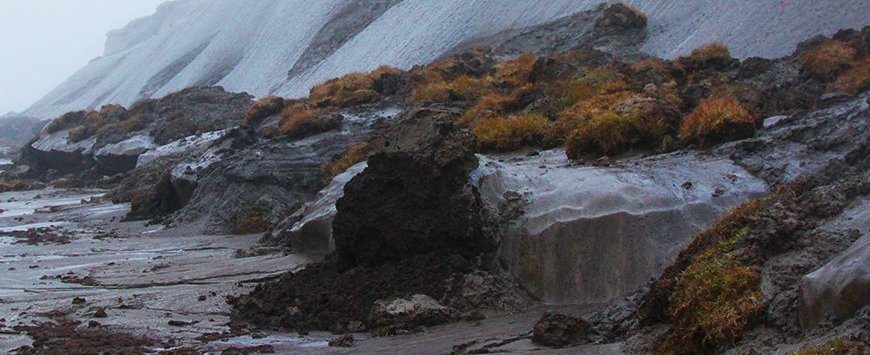Global warming in arctic latitudes results in thawing permafrost. This leads to the mobilisation of large amounts of carbon, potentially forming the greenhouse gas methane. Recent studies showed that microbial activity in submerged permafrost may prevent large amounts of this methane to be released to the water column and the atmosphere. For the first time, scientists from the Helmholtz Young Investigators group MicroCene, led by Susanne Liebner, GFZ section Geomkirobiology, were now able to identify the methane reducing microorganisms.
The team investigated microbial communities in frozen and already thawed sediments in coastal regions of the Laptev Sea in eastern Siberia. The organisms are adapted to extreme conditions with deep temperatures and no oxygen. They process methane instead of oxygen thus degrading methane. Based on genetic and geochemical investigations the scientists were able to detect methane-reducing microbes in an unexpected diversity. For the first time, they identified an association of microbes of continental and of marine origin. This co-existence may play an important role for methane-degradation.
Results may have an impact on arctic greenhouse gas balance
In their study, published in Scientific Reports, the scientists show that about 70 to 100 percent of the methane released by thawing is reduced by microbial activity already within the sediment and thereby kept from being released to the water column and the atmosphere. They were also able to show that the microbes not only reduce the methane along the thaw-line but also within deeper, still frozen layers of the sediment. Matthias Winkel, first author of the study: “There is considerable evidence that the reduction of methane already starts before the sediments are completely thawed.”
It remains an open question how common these microbial communities are in permafrost regions beyond the investigated area. Susanne Liebner: “Future studies need to show whether the reduction of methane by microbial activity in oxygen-free permafrost sediments is the exception or the rule.” Depending on how widespread this phenomenon is, it may have an impact on the amount of the greenhouse gas methane released from thawing permafrost soils. “Our results should be considered in future carbon-dynamic models of permafrost areas since their effect on the greenhouse gas balance may be vast”, says Winkel. (ak)
Original study: Winkel, M., Mitzscherling, J., Overduin P. P., Horn, F., Winterfeld, M, Rijkers, R., Grigoriev, M. N. Knoblauch, C., Mangelsdorf, K., Wagner, D., Liebner, S, 2018. Anaerobic methanotrophic communities of marine and terrestrial origin thrive in deep submarine permafrost. Scientific Reports. DOI: 10.1038/s41598-018-19505-9








![[Translate to English:] Torsten Sachs in front of a climate station on a field](/fileadmin/_processed_/3/9/csm__TorstenSachs_bearbeitet_GS_4a1365ef84.jpeg)

![[Translate to English:] left image flood at the Ahrtal: image from above, several houses are flooded; left image:: Heidi Kreibich;](/fileadmin/_processed_/4/4/csm_Bild2_9af0130e9f.png)



![[Translate to English:] Start der Vega Rakete](/fileadmin/_processed_/6/4/csm_20231201-kachel_Vega-VV23-launch_ESA-CNES-Arianespace_706716b68c.jpeg)









![[Translate to English:] Poster exhibition at the Brandenburg Hydrogen Day at the GFZ, some participants in the foreground](/fileadmin/_processed_/6/5/csm_Erster_Brandenburgischer_Wasserstofftag_GFZ_402fcec95e.jpeg)
![[Translate to English:] Group picture of the participants](/fileadmin/_processed_/9/4/csm_20231108_CAWa-Workshop-Tashkent_Gruppenbild_99ea779d8a.jpeg)

![[Translate to English:] [Translate to English:] Hörsaal](/fileadmin/_processed_/e/6/csm_H%C3%B6rsal_e21ac645fb.jpeg)


![[Translate to English:] The Delegations in the Historic Library on the Telegrafenberg. In the back there are from left to right, the Dutch Ambassador for Germany, Ronald van Roeden, the Dutch Minister for Education, Culture and Science, Robbert Dijkgraaf and the scientific director of the GFZ, Susanne Buiter.](/fileadmin/_processed_/d/b/csm_Kachel-2_9eba4b4212.jpeg)

